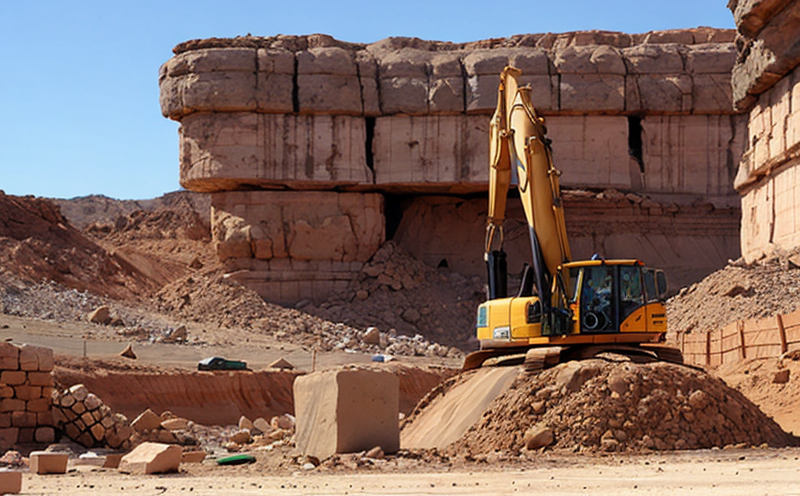DIN 22028 Rock Mass Permeability Testing
The DIN 22028 standard outlines a method for determining rock mass permeability. This testing is crucial in mining and geotechnical engineering to assess the hydraulic properties of rock masses, which can influence the stability and design of underground structures such as mines and tunnels.
Permeability tests are performed on intact or fragmented specimens obtained from excavation sites. The test setup involves placing a sample in a permeameter where water is gradually passed through it under controlled pressure. The volume flow rate of water is measured, which allows for calculating the hydraulic conductivity (K) and subsequent permeability.
The procedure described by DIN 22028 is designed to provide accurate measurements that are essential for predicting ground behavior under various loading conditions. This helps in understanding how fluids will move through rock formations, impacting areas like groundwater flow, mine dewatering systems, and the stability of excavation slopes.
Specimens can be prepared in different sizes depending on the scale of investigation; however, the method is primarily aimed at intact rocks or large fragmented pieces. The testing apparatus includes a permeameter equipped with pressure transducers and data acquisition systems to ensure precise measurement.
The results from these tests are used by mining companies to make informed decisions regarding mine design, excavation plans, and safety measures. For instance, if the rock mass has low permeability, it might indicate that water will not easily flow through the formation, which could affect dewatering efforts or drainage systems within mines.
The accuracy of DIN 22028 testing is paramount in ensuring safe operations and efficient resource management. Compliance with this standard ensures consistency across different projects and adheres to international best practices. This aligns with ISO standards that promote quality assurance and reliability in engineering processes.
| Test Parameter | Description |
|---|---|
| Hydraulic Conductivity (K) | The ability of a rock to transmit water, measured through the permeameter during testing. |
| Specimen Size | Varies based on the project requirements but typically ranges from small lab samples up to large excavation cores. |
| Pressure Applied | Controlled pressure applied to achieve consistent flow rates for accurate measurement. |
| Data Acquisition System | Used to capture and record all relevant data during the testing process, ensuring traceability and accuracy. |
The methodology described in DIN 22028 is widely recognized for its robustness and reliability. It provides a standardized approach that can be replicated across different locations, contributing to the overall quality of construction projects and environmental impact assessments.
Industry Applications
- Mining Industry: Evaluating rock mass stability in underground mines.
- Tunnel Construction: Assessing ground conditions for safe excavation.
- Dewatering Systems: Optimizing the design of dewatering systems within mines.
- Environmental Impact Studies: Understanding groundwater flow and its interaction with mining operations.
The data obtained from DIN 22028 testing plays a critical role in these applications by providing insights into the hydraulic properties of rock formations. This information is vital for ensuring that mining activities are conducted safely and efficiently while minimizing environmental disruption.
| Application | Description |
|---|---|
| Mining | Evaluation of rock mass stability in underground mine environments. |
| Tunnel Construction | Assessment of ground conditions for safe excavation and construction. |
| Dewatering Systems | Optimization of dewatering systems within mines to improve operational efficiency. |
| Environmental Impact Studies | Understanding groundwater flow dynamics in relation to mining operations. |
The results from DIN 22028 testing are essential for various stakeholders, including mine operators, engineers, and environmental scientists. By providing accurate data on rock mass permeability, these tests contribute significantly to the overall success of mining projects and sustainable development practices.
Eurolab Advantages
At Eurolab, we offer comprehensive DIN 22028 testing services tailored to meet the specific needs of our clients in the mining sector. Our experienced team ensures that every test is conducted according to international standards, guaranteeing precision and reliability.
We employ state-of-the-art equipment and adhere strictly to ISO guidelines, ensuring consistent results across multiple projects. With years of experience in geotechnical testing, Eurolab provides detailed reports that not only meet regulatory requirements but also offer valuable insights into rock mass properties. Our services are supported by advanced data analysis capabilities, enabling us to identify potential issues early on and provide proactive recommendations.
Our commitment to quality is reflected in our ISO 9001 accreditation, which ensures that all processes are documented and reviewed regularly. This rigorous approach helps maintain high standards of performance and reliability throughout every testing process.
By choosing Eurolab for your DIN 22028 rock mass permeability tests, you can be assured of receiving accurate, reliable data that will contribute positively to your project outcomes. Our expertise in this field ensures that you have access to the latest techniques and methodologies, ensuring that your testing meets both current standards and future requirements.
Quality and Reliability Assurance
EuroLab adheres strictly to international standards like DIN 22028 when performing rock mass permeability tests. Our quality management system is ISO 9001 certified, ensuring that all processes are documented and reviewed regularly. This commitment to continuous improvement guarantees consistent high-quality results.
Our testing facilities are equipped with the latest technology and calibrated instruments to ensure accuracy and precision in every measurement. Rigorous training programs for our staff members ensure they stay updated on the latest techniques and methodologies, further enhancing the reliability of our services.
We maintain comprehensive documentation throughout the entire testing process, from sample preparation through data collection and analysis. This meticulous approach allows us to provide detailed reports that not only meet regulatory requirements but also offer valuable insights into rock mass properties.
Our quality assurance measures extend beyond just technical aspects; we also ensure environmental sustainability by minimizing waste generation during tests and using energy-efficient equipment where possible. By adhering to these practices, EuroLab demonstrates its dedication to responsible testing and assessment within the mining industry.





